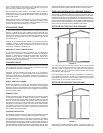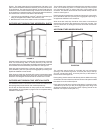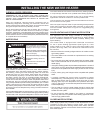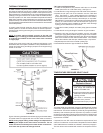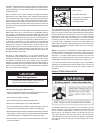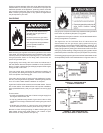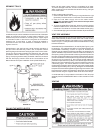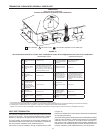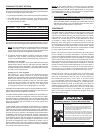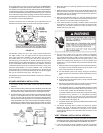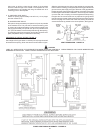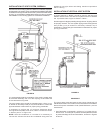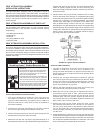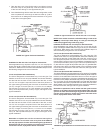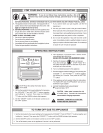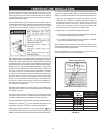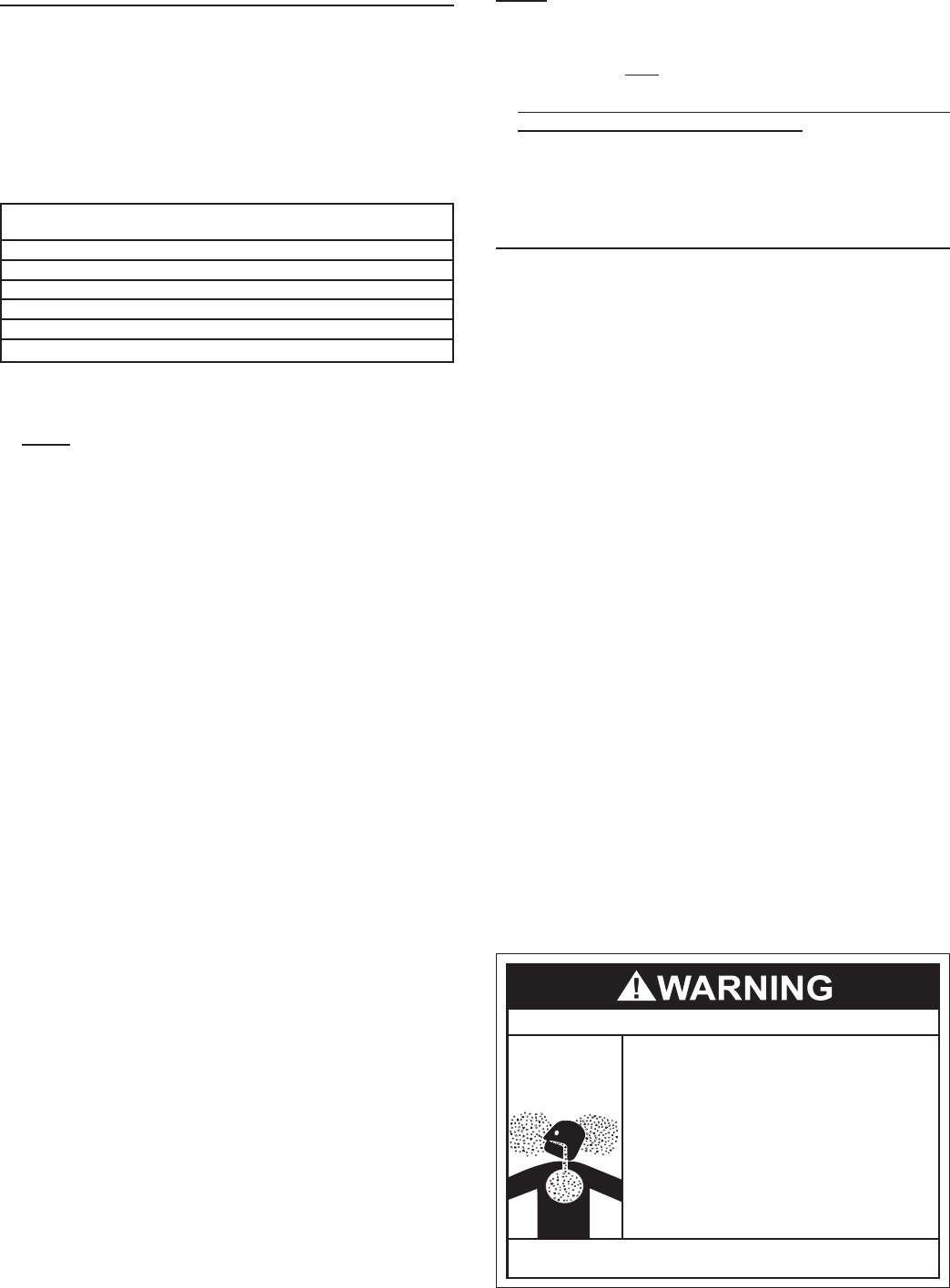
20
PLANNING THE VENT SYSTEM
Plan the route of the vent system from the discharge of the blower
to the planned location of the vent terminal. Refer to VAA instruction
on page 24 while planning the vent system.
1. Layout total vent system to use a minimum of vent pipe and elbows.
2. Thiswaterheateriscapableofventinguegasesequivalent
to25’(7.6m)of2”pipe,65’(19.8m)of3”pipe,or128’(39.0m)
of 4” pipe as listed in Table 1.
TABLE 1
Number of 2” Maximum 3” Maximum 4” Maximum
90° Elbows Pipe - ft. (m) Pipe - ft. (m) Pipe - ft. (m)
1 20 (6.1) 60 (18.3) 120 (36.6)
2 15 (4.6) 55 (16.8) 112 (34.1)
3 10 (3.0) 50 (15.2) 104 (31.7)
4 -- 45 (13.7) 96 (29.3)
5 -- 40 (12.2) 88 (26.8)
6 -- 35 (10.7) 80 (24.3)
Theminimumventlengthsforeachofthepipesizesisone90°ontopof
theunitplus2’(61cm)ofstraightpipeandtheappropriatetermination.
NOTE: The equivalent feet (m) of pipe listed above are exclusive
of the termination. That is, the termination, with an installed
screen, is assumed to be in the system and the remainder of the
system must not exceed the lengths discussed above.
3. The blower discharge adapter is made to accept only straight
sections of 2” pipe. To start, a minimum of 2 inches (5.1 cm) of
2” pipe must be attached to the blower discharge, see Figure 17.
If using 2” inch vent pipe:
A minimum of 2 inches (5.1 cm) must be attached to the blower
beforethe rst elbow.Aftertherstelbowadd theadditional
venting required for the installation. The total system cannot
exceed the lengths discussed above, where each elbow is equal
to 5 feet (1.5 m) of straight pipe.
If using 3” or 4” inch vent pipe:
Two inches (5.1 cm) of pipe must be attached to blower
discharge before adding a reducer to acquire desired pipe
diameter. An appropriately sized 45 degree schedule 40 DWV
elbow (field supplied) vent terminal must be obtained with
an equivalent screen (supplied in vent kit). The total system
cannot exceed equivalent pipe lengths discussed above
where each elbow is equal to 5 feet (1.5 m) of straight pipe
(3” vent pipe) or 8 feet (2.4 m) of straight pipe (4” vent pipe).
Installation of this water heater must comply with CAN/CSA B149.1 -
Natural Gas and Propane Installation Code which requires the vent
systemcomponentsbecertiedtoULCS636.
ThiswaterheaterhasbeendesigncertiedtobeventedwithPVC
orCPVCpipecertiedandmarkedascomplyingwithULCS636.
This water heater is supplied with a 2 inch 22.5 degree termination
elbow.Anyoutletpiping,ttingsandglueusedtoventthisappliance
that is not supplied by the manufacturer must comply with the ULC
S636 requirements.
If water heater is being installed as a replacement for an existing
power vented heater in pre-existing venting, a thorough inspection
of existing venting system must be performed prior to any installation
work. Verify that correct material as detailed above has been used,
and that minimum or maximum vent lengths and terminal location
as detailed in this manual have been met. Carefully inspect entire
venting system for any signs of cracks or fractures, particularly at
jointsbetweenelbowsandotherttingsandstraightrunsofvent
pipe. Check system for signs of sagging or other stresses in joints
as a result of misalignment of any components in system. If any of
these conditions are found, they must be corrected in accordance
with venting instructions in this manual before completing installation
and putting water heater into service.
NOTE: A. For water heaters in locations with high ambient
temperaturesabove100°F(38°C)itisrecommendedthatCPVC
pipeandttingsbeused.B. A 22.5 degree elbow (2” vent pipe) or
a 45 degree elbow (3” and 4” vent pipe) with an installed screen
VENT TERMINAL must be used in all cases.
4. There will be some installations where condensate will be formed
in the horizontal runs of the vent system. This condensate will
run into the condensate boot attached to the blower and out the
tting.Thewaterheaterisshippedwithcondensatehosethat
attachestothettingonthecondensateboot.NootherTeeor
ttingisrequired.SeeFigures17,20and21.
CONDENSATE
This water heater is a condensing unit and requires a drain to be
located in close proximity to allow condensate to drain safely.
One hose from blower housing, two flexible hoses from blower
outlet adaptor, along with another flexible hose from VAA if
installed, run to barb fittings on vent pipe assembly #2. Hose
is clamped by rubber clips and flexible hoses by a clamp on
jacket top cover. See Figure 17. Condensate drains from the unit
at the exhaust tee located at the bottom of the unit (see figure
16). Condensate from this water heater is mildly acidic. Please
note that some local codes require that condensate is treated
by using a pH neutralizing filter prior to disposal.
NOTE: It is important that the field supplied drain lines beyond
the 1/2” adaptor of vent pipe assembly #1 should be installed
continuously tilted downward toward an appropriate drain. See
Figure 16. If these instructions are not followed or if condensate
drain line is blocked, water will spill from condensate trap. Do not
block the holes in the hex plug on top of a small tee in vent pipe
assembly #1. As with every water heater installation, a drain pan
should be used to prevent water damage to surrounding area. If
necessary, a condensate pump with an incorporated reservoir
may be used to pump water to an appropriate drain. To avoid
condensate spillage, select a pump with an overflow switch.
Caution must be used to ensure that drain is free and clear
of debris and will not allow backflow through the condensate
drain line. Consideration must be given to avoid freezing of
the condensate lines which could result in excessive build
up of condensate inside the water heater. Waterproof heat
tape may be required to prevent freezing of condensate lines.
Please ensure that the outlet of condensate drain does not
create a slippery condition which could lead to personal injury.
Care should be taken to ensure there is no kink or twist in any
condensate hose. If a VAA is not installed, the unused barb
fitting in vent pipe assembly #2 should be plugged using one
of the break-away plugs.
Breathing Hazard - Carbon Monoxide Gas
•
Do NOT block the holes in the hex plug of vent pipe
assembly #1.
•
Do NOT elevate any portion of the field supplied drain
line beyond the 1/2" adaptor above the adaptor. This
must be true for entire length of the drain line including
the exit into an appropriate drain
.
•
Condensate lines must be free and clear of debris and
must not allow back flow through drain line. Condensate
lines must be able to flow freely to an appropriate drain.
•
Do not allow condensate lines to become crimped closed.
•
Analyze entire vent system to make sure that condensate
will not become trapped in a section of vent pipe and
therefore reduce open cross sectional area of vent.
Breathing carbon monoxide can cause brain damage or death.
Always read and understand instruction manual.



